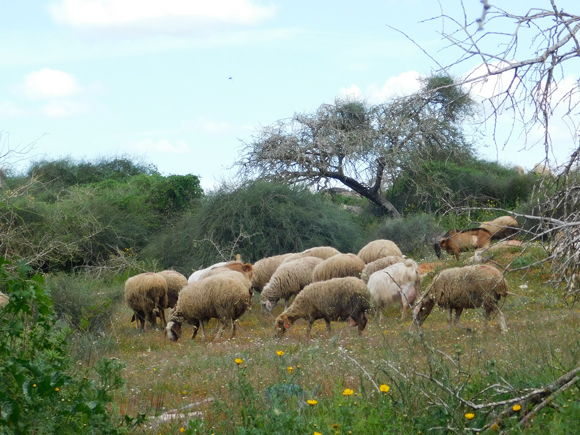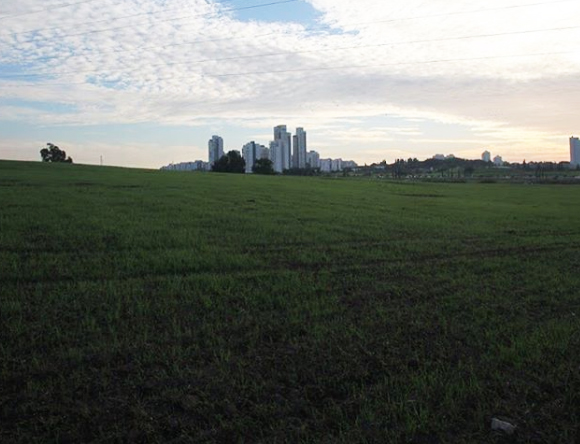A small patch of African savanna has found itself on top of a hill near Rehovot. What does it tell us about nature in Israel?
Located on the Mediterranean shore, the Land of Israel’s plants and wildlife are similar to those of other Mediterranean countries, like Turkey and Greece. There, too, we can find oak groves, pine tree forests, and fields of anemone. Nevertheless, the African continent lies a mere 200 kilometers away, and over the ages, some species from tropical Africa travelled to the Land of Israel and settled here. Plants and animal species with ancestors from Kenya and Sudan can be found throughout the land, especially in its warmer valleys – but not in the groves of Southern Europe. These species include the graceful prinia, the orange-tufted sunbird, and such trees as the Ana tree (Faidherbia albida), an acacia species that grows in the Ana Tree Reserve east of Rehovot.
With its branching stems, white trunk, and greyish leaves, the Ana tree grows in Africa’s savannas and alongside rivers south of the Sahara Desert. But it can also be found in a number of isolated natural groves in Israel, where it creates a savanna-like landscape, dominated by a grassy vegetation with scattered trees. In some cases, they are accompanied by other tropical plants, such as the Christ's thorn jujube and the Halfa grass, but mainly by local Mediterranean plants. Most of these groves can be found in the southern region of Israel's Coastal Plain. There are conflicting views about the origin of these groves, but they are commonly thought to be relicts of ancient vegetation.

Over the last 2.5 million years, Earth underwent numerous climate changes. During this stretch of time, there were periods in which the Land of Israel was subject to warmer or colder, rainier or dryer weather. In each period, the species populating the area were those that were better adapted to its climate, while species from the previous climate period disappeared or survived only in habitats that preserved conditions similar enough to those of the previous period. Called relicts, these species include, for instance, forest plants that remained in oases and species originating in warmer periods that can still be found in the warmer valleys.
The Ana tree, for instance, had probably spread to Israel hundreds of thousands of years ago, if not earlier, when regional climate was tropical and similar to Eastern Africa’s. It survived thousands of years of tree-clearing in the Coastal Plain due to its asexual reproductive abilities: Rather than spreading seeds that require fertilization, each tree can grow a new, genetically identical, tree out of its roots. Thus a single tree can generate acacia cover over the landscape within a number of years.

The African tree now grows in a number of isolated natural groves in Israel. Ana tree in Rehovot | Photograph: Yuval Rosenberg
Disappearing Ana trees
Although the Ana trees survived thousands of years of human settlement on the Coastal Plain, they are not keeping up with the pace and technology of modern civilization. Ana tree groves throughout the country are endangered due to the expansion of cities, industrial areas, and agricultural activity. Some of them are located next to large populated areas, like the remarkable groves of Ashdod and Yavneh, making them especially vulnerable. This is illustrated by the case of the grove that formerly existed near Jaffa, of which one tree at the heart of Neve Tzedek neighborhood now remains.
The Ana Tree Reserve near Rehovot is a good example of the species’ precarious existence in the region. It is located in the open area east of the city, a mostly agricultural area with some isolated natural sites, including Rehovot's winter pond, and two hills, HaTisanim and HaZeitim. Each site preserves a different aspect of local nature, and includes many rare plant and animal species. Because of the paving of new roads and building of new neighborhoods, these habitats face a continuous process of shrinking and fragmentation. Additional threats are posed by a variety of other hazards, including waste disposal, the presence of off-road vehicles, and unauthorized agriculture.

The city and the crops are suffocating nature. Fields and neighborhoods in East Rehovot near Ana Tree hill | Photograph: Yuval Rosenberg
The time machine
The grove east of Rehovot currently covers a small hill-top stretch, while every other nearby hills was taken over by orchards, fields, roads, and houses – all manmade landscapes. And the Ana tree grove? It was there when Rehovot was first established as a small settlement and the orchards were just planted. It was there for thousands of years of human settlement, wars, abandonment and resettlement; it was there in the Iron Age, 3,000 years ago, during the Kingdom of Israel’s golden era, when the leaves were nibbled by antelopes and ostriches, as lions and cheetahs lurked in the tall grass – all creatures of the African Savanna, and all, to our ancestors, just as Israeli as today’s grove inhabitants – rabbits and foxes.
The grove was there earlier, much earlier. It was once larger, and it is possible that at some point all Ana tree groves in the land were interconnected to form one vast Ana tree-dominated savanna – we do not know. We do know that now few patches of this ancient landscape remain, and they are also diminishing from year to year.
Simultaneously with the destruction, a battle to preserve this piece of natural landscape, along with the natural treasures it harbors, is now underway. For better or worse, these processes will determine whether the ancient Ana tree species will continue to be a part of our region, together with the unique ecosystem it created around it. If not, the future will have us travelling to Tanzania to see what once grew a walking distance from home.
Translated by Elee Shimshoni
